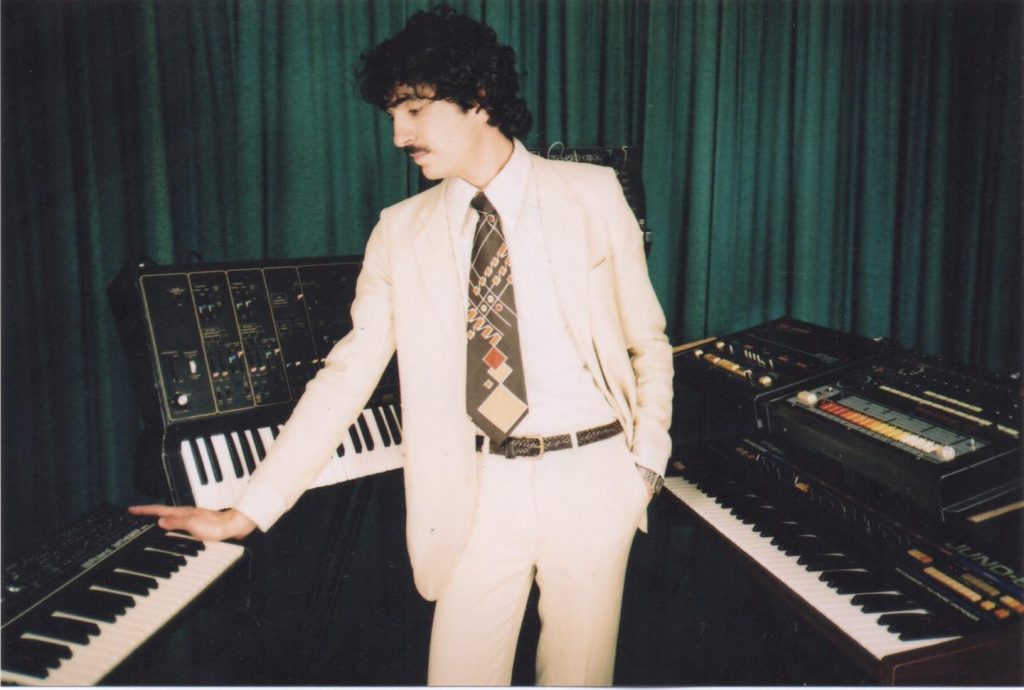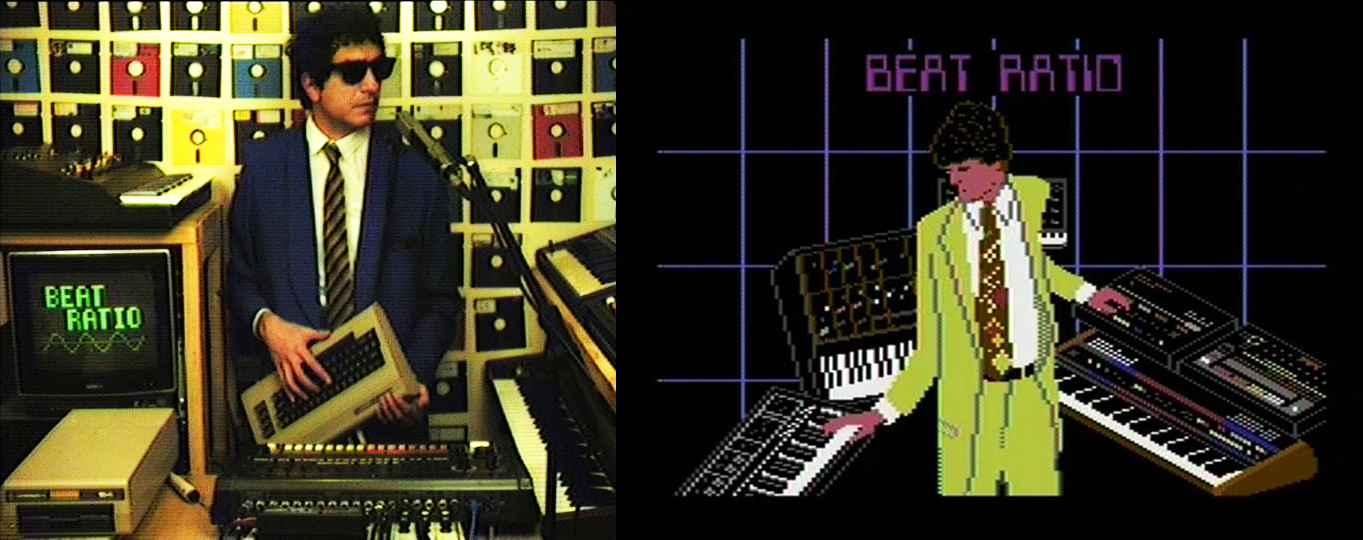By Keith Walsh
In my previous article with Gab of Beat Ratio, he told me about the creation of his cover of Toto Cutugno’s ‘L’Italiano,’ and how he used only vintage analog synth gear (with the exception of the Roland Juno 60, which has digital oscillators but an analog filter and workflow).
In part two of our interview he gets more specific, for example discussing why he drew the cutoff point for technology at 1983, how he maintains his vintage analog synth gear, and how he began to incorporate the Commodore 64 computer into his sound after initially using it to create graphics.
Synthbeat: How do you use the Commodore 64?
Gab: “Initially I was using the C64 only for creating pixel-graphics for my website but, after being invited to perform at the Commodore Retro eXpo Bitscape music festival last year, I decided it was finally time to learn to program it. I ended up teaching myself Basic as I didn’t want to use any C64 music software made after 1983 and the few that met that criteria were either very limited or full of glitches.”
“I created some stripped down arrangements of my songs in order to give the C64 a dominant role and designed some custom programs and routines to control the SID chip.”
“You can see the performance here:”
“I now use the C64 increasingly in my music and I’m sure it will appear on several songs of the EP.””
(Gab explained his use of the Commodore 64 involves a program called Koala Paint, and lots of patience.)
Synthbeat: ‘Electric Devolution’ is very reminiscent of Depeche Mode and Yaz of 1981. Similar vintage gear I’m sure. Is it your first official release as Beat Ratio?
Gab: “Vince Clarke and other artists from the British new wave scene are a big inspiration for me; not only for their music but also because the equipment I use now –made before or up to 1983– is similar to what they would have used back then.”
“When I wrote Electric Devolution I had just decided to switch to analog sequencing so I challenged myself to create a song using just one mono synth (Roland SH-101) and one drum machine (TR-808). I wanted to write a song that celebrated a time when “hardware had soul” before the focus shifted in a major way on reducing manufacturing costs instead of creating a quality product that would last the distance. While Electric Devolution is not my first release, I feel it’s the first of the creative phase I’m in right now. It’s definitely got some rough edges and now that I’m more familiar with the analog recording process perhaps I would do some things differently, but I kind of like that ‘unpolished’ aspect. After all, if I was after hi-fi quality I probably wouldn’t use technology that is four decades old on average!”
Synthbeat: When is the EP due?
Gab: “I wish I could give an exact timeline but working exclusively with vintage equipment means the timescale is quite loose. The potential for unexpected issues to crop up is very high and recording on physical media is already an inherently convoluted process in itself. Some may think that this would hamper creativity, but I think that on the flip-side it also forces you to think about every step more deeply. You end up really getting to know your equipment which in return can generate inspiration. In terms of a rough timescale, I’m hoping to have a cassette EP out in the first half of this year perhaps preceded by another single and/or music video.”
Synthbeat: . What was your childhood musical education (who can you thank for the gift of music?)
Gab: “I never really trained classically. In my early teen I discovered music and like most kids gravitated towards guitar. My favourite band at the time was Sonic Youth so my main interest lied more in creating unusual sounds than achieving any particular level of technical proficiency. I experimented with alternate tunings and huge arrays of pedals then in my early/mid 20s I developed an interest in electronic music thanks to some DJ friends. I was still using DAWs at the time but kept getting lost in the endless possibilities they offered so one day I bought an old Tascam 4 track recorder and had a sort of revelation about a working process that almost immediately felt much more intuitive to me.”

Synthbeat: Any temptation to use modern replications of these vintage synths??
Gab: ”None at all. I feel today there is a big focus on how closely these modern versions replicate the sound of the originals with some people obsessively A/B testing and debating online. But sound is only half the story; what really counts in my opinion is the ‘experience’ the equipment offers with its strong and weak points, its qualities and limitations.
To make music you need to seek out what inspires you so while I have absolutely nothing against anyone using modern replicas, I just find that often what some of these machines lack is precisely the fact that they don’t ‘lack’ anything.”
“Many of these in fact add exponentially to the capabilities of the original with extra features, filters, built-in drums, sequencers, samplers and lights… so many lights! Whenever I see these hybrids which only vaguely resemble their vintage counterparts I feel the end user is being a bit cheated into buying something by cashing in on the popularity of the originals but ending up with an almost entirely different instrument.”
“I’m by no means saying that my approach is better or worse than anyone else though. Just like I thrive on working within the constraints of vintage technology, someone else might enjoy and be able to make the most out of the amazing options that modern gear can offer. At the end of the day it’s about finding what works best for you.”
Synthbeat: What are the challenges of keeping these vintage synths functional?
Gab: “Where to start! As previously mentioned, most of the equipment I use is around 40 years old so each time they power up, that alone feels like a small miracle (especially when you compare it to modern manufacturing where ‘planned obsolescence’ seems to be the norm). But keeping these machines alive is, in all honesty, an ongoing struggle. Luckily I studied electronics in high school so I am able to do most minor repairs and regular maintenance myself, but sadly they can develop anything from minor faults to catastrophic failures without any warning and for no apparent reason. When the issue is beyond my capabilities, getting these machines repaired can be quite expensive so it’s always worth factoring in some extra cost to keep them going just like you would with an old car.”
Synthbeat: How did you acquire this gear?
Gab: “In the usual ways I guess, ebay, gumtree, facebook, friends of friends etc… People see the equipment and think “wow, you must be rich!” But that is not the case, I have a normal job (I work at an art gallery here in Melbourne) and the equipment I’m using today I’ve put together over the past 10 or so years. It seems like around five or so years ago prices of vintage equipment suddenly skyrocketed so I feel lucky to have bought most things before then. I’m not sure exactly what triggered this spike in prices but it did seem to coincide with modern replicas of vintage equipment coming into the market in a big way (which, paradoxically, I expected would generate the exact opposite effect).
It’s also worth remembering that this gear would have cost you a pretty penny even back then (adjusted for inflation a Juno 60 would be close to $5000 USD in today’s money!) so even with the high prices of today, we are often still paying a fraction of what a struggling musician would have paid at the time.”
Synthbeat: How long since you’ve left Italy?
Gab: “I left in 2005. Sadly I’m afraid that for many years I used my external point of view only to observe the flaws of my country and was often critical towards it. But in recent times, thanks in part to the overwhelming feeling of distance created by the current world events, I rediscovered an appreciation for the many things about my culture that perhaps I had always taken for granted. I hope to be able to visit very soon.”
Synthbeat: What was the significance of 1983 in synth technology that found you cutting off at that point?
Gab: “Up until one or two years ago I had this ‘gear cutoff date’ set to 1985 as I felt that was the year in which ‘80s-ness’ reached its truest form, having definitively left the 70s behind but having not yet started mutating into what the early 90s would become either.”
“From a purely gear perspective though, I was increasingly fascinated by what people like Giorgo Moroder, Suzanne Ciani and bands such as YMO, Kraftwerk, Human League, Depeche Mode etc. were able to achieve just by using analog sequencers. I wanted to try out that challenge and ended up really enjoying the added limitations.”
“Also, by taking MIDI out of the equation, suddenly polyphonic sequencing was no longer possible so every chord had to be played by hand during recording. This meant a lot more hands-on time on the keys which in turn had the positive side effect of inspiring new musical ideas; a sort of ‘creative cycle’ which I’m very happy to be ‘stuck’ in. As I decided not to use MIDI in any of my arrangements, 1983 –the year MIDI was introduced– felt like a good cutoff date for equipment used in the project.”
Beat Ratio On Facebook
BeatRatio.com
finis
